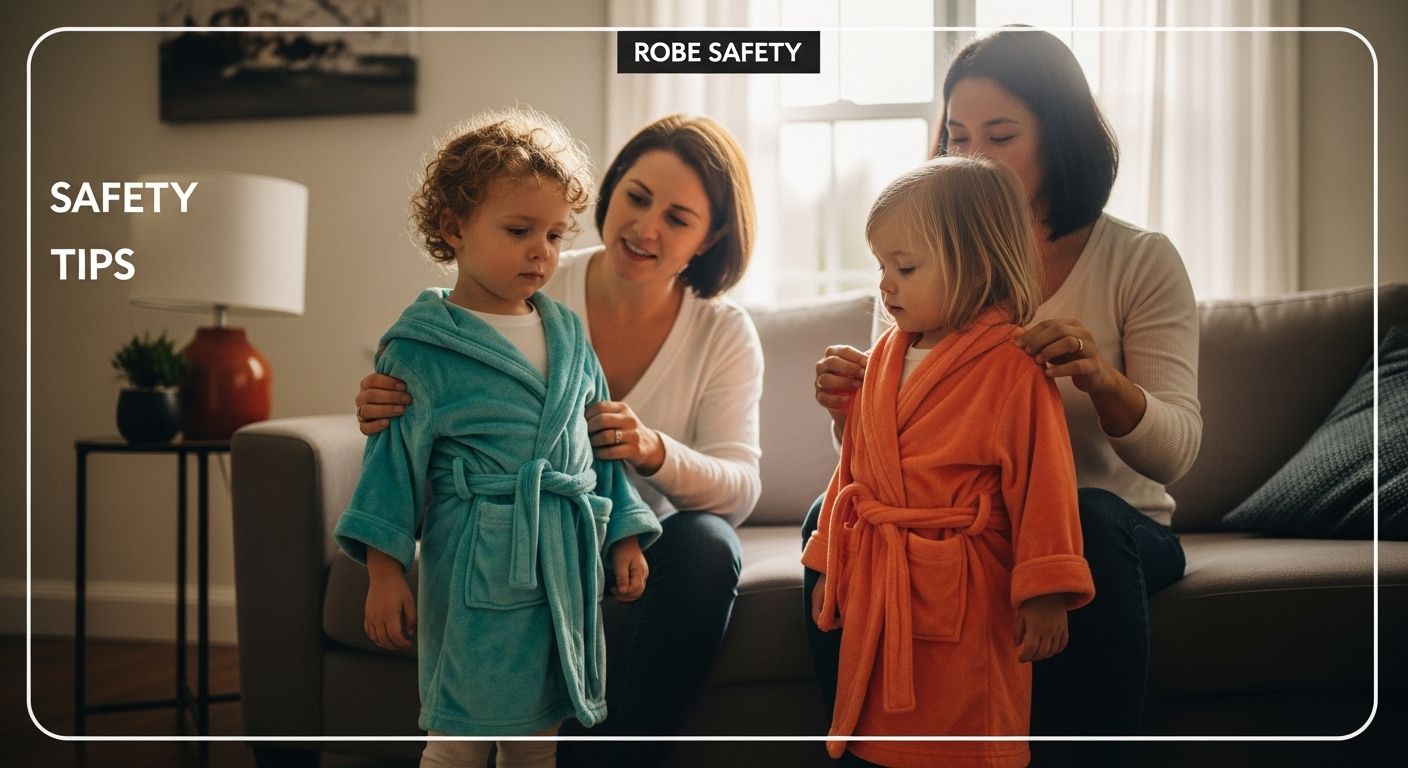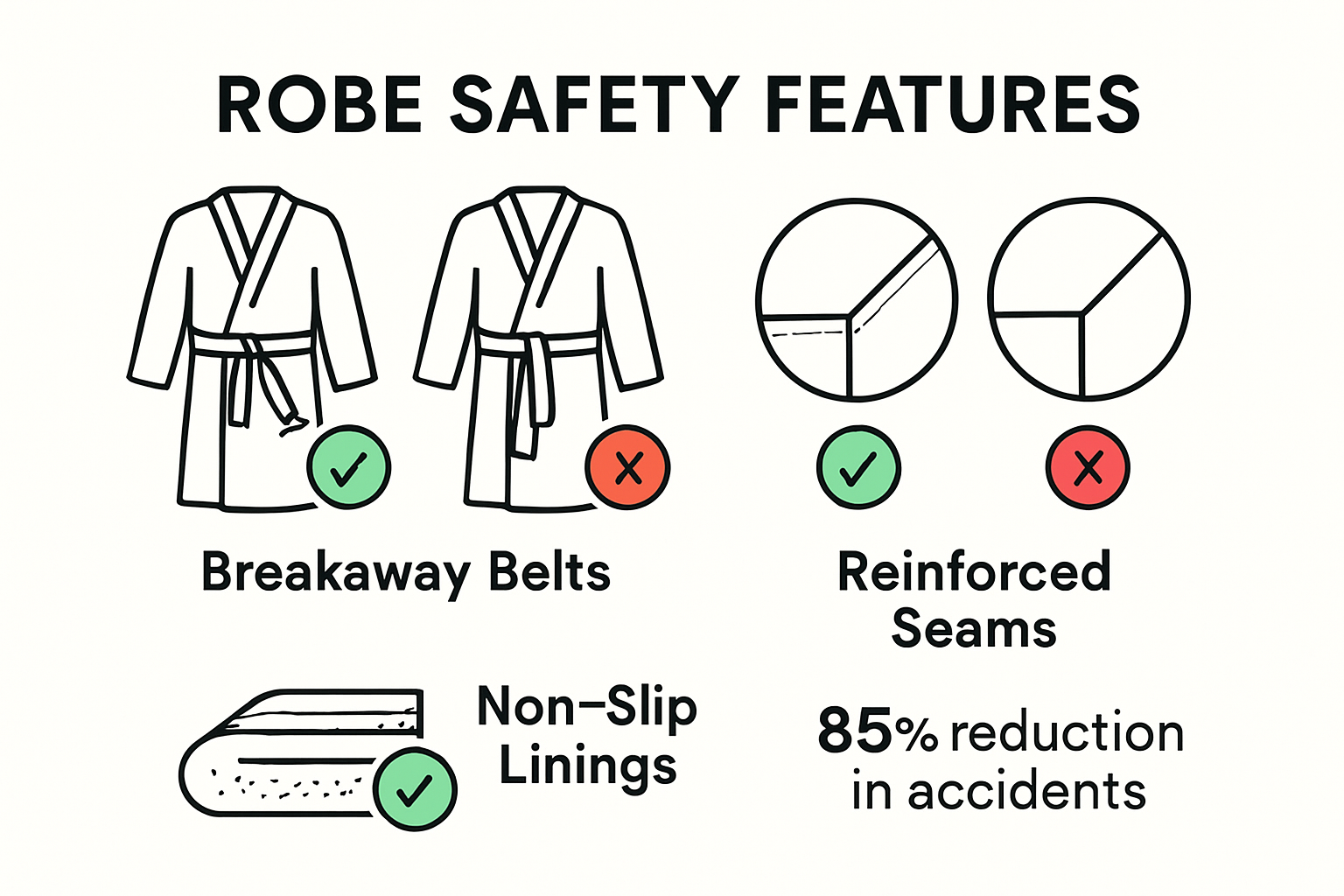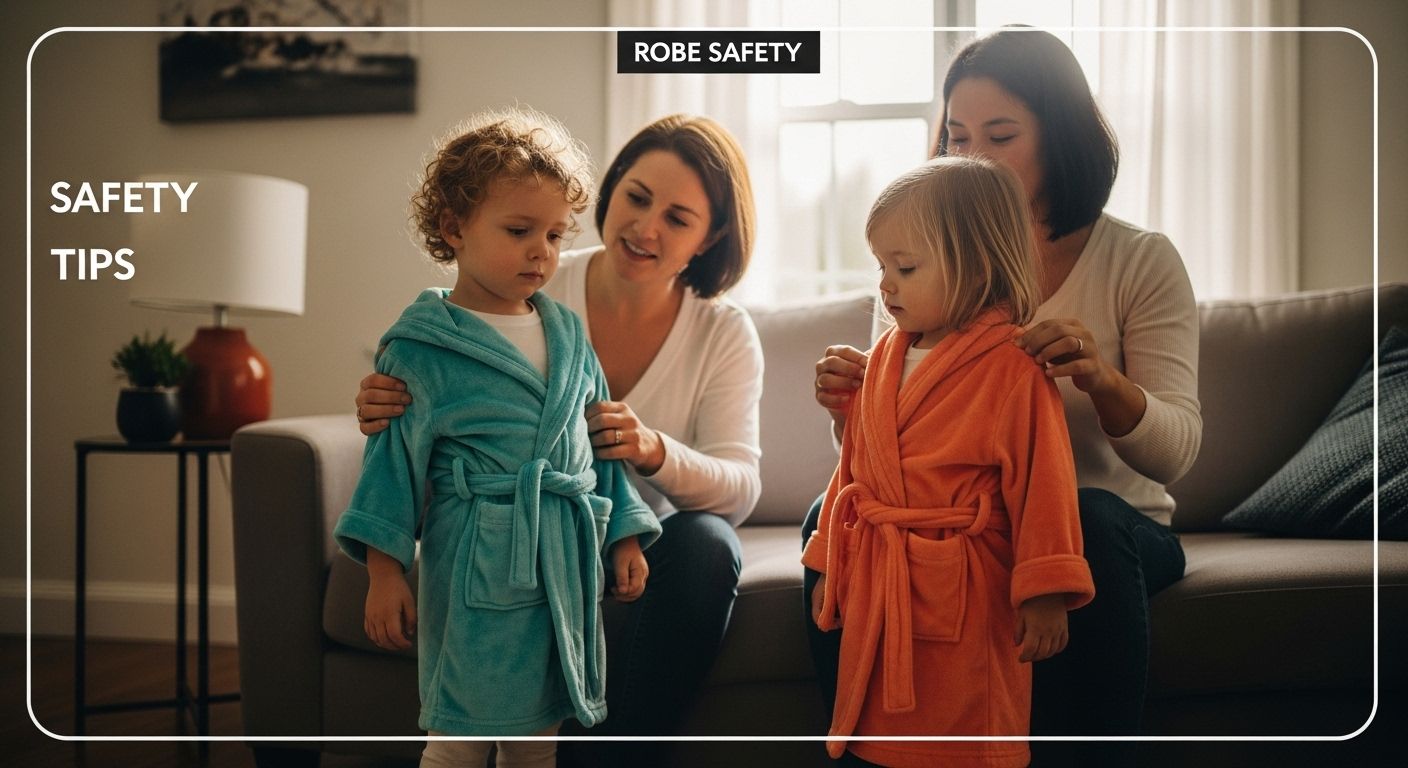
Kids’ robes should be soft and adorable, but safety matters even more. Few parents realize that over 3,000 children are injured every year by flammable sleepwear and robe accidents. Many robes that look cozy actually hide dangerous fabric risks parents would never expect. Safe designs involve much more than just picking a cute pattern, and some of the smartest robe choices for 2025 include surprising safety features most buyers miss.
Table of Contents
- Choosing Safe and Comfy Robes for Kids
- How to Spot and Avoid Flammable Fabrics
- Design Features That Make Robes Safer
- Proper Robe Care to Maintain Safety
Quick Summary
| Takeaway | Explanation |
|---|---|
| Choose flame-resistant materials | Opt for robes made of cotton or bamboo, which offer both comfort and enhanced safety. |
| Ensure proper sizing for fit | Select robes that fit well to prevent accidents from tripping or entanglement. |
| Incorporate safety features in design | Look for robes with breakaway belts and non-slip linings to enhance safety during wear. |
| Follow specific care instructions | Implement proper laundering techniques to maintain the protective qualities of children’s robes. |
| Regularly inspect and replace worn robes | Check for any signs of wear, as damaged robes can pose safety risks for children. |
Choosing Safe and Comfy Robes for Kids
Selecting the right robe for children involves more than just picking a cute design. Safety, comfort, and practicality are crucial factors that parents must consider when shopping for kids’ robes. Understanding the key elements that make a robe both safe and enjoyable can help parents make informed decisions.
Material Matters: Selecting Safe Fabrics
The fabric of a child’s robe plays a critical role in both safety and comfort. Consumer Product Safety Commission recommends choosing materials that are flame-resistant and hypoallergenic. Cotton and bamboo fabrics emerge as top choices for children’s robes, offering breathability and minimal skin irritation risk.
Parents should look for robes with specific safety features. Lightweight, soft materials prevent overheating and reduce the risk of accidental tripping. Robes with smooth, flat seams minimize skin chafing, while stretchy fabrics allow for easy movement. American Academy of Pediatrics emphasizes the importance of choosing robes that don’t restrict a child’s natural movement or create potential hazards.
Below is a table comparing various robe fabric types and their safety features to help parents identify the safest options for kids:
| Fabric Type | Flame Resistance | Comfort/Breathability | Skin Irritation Risk | Notable Features |
|---|---|---|---|---|
| Cotton (treated) | High (when flame-retardant) | Excellent | Low | Breathable, soft, hypoallergenic |
| Bamboo | Good | Excellent | Low | Breathable, naturally antimicrobial |
| Wool | Very High | Moderate | Moderate | Self-extinguishes, good insulator |
| Silk | High | Good | Low | Natural fiber, comfortable |
| Polyester/Nylon | Low (unless specifically treated) | Moderate | Moderate/High | Can melt in heat, may cause burns |
| Acrylic | Low | Moderate | Moderate | Synthetic, higher flammability risk |
Design Considerations for Maximum Safety
Robe design goes beyond aesthetic appeal. Key safety features include secure belt loops, breakaway belt mechanisms, and appropriate length. An ideal kids’ robe should hit just above the ankle to prevent tripping, with adjustable closures that prevent accidental loosening.
Consider robes with additional safety innovations. Some modern designs feature:
- Slip-resistant backing on the interior to prevent sliding on smooth surfaces
- Reinforced shoulder areas to withstand active play
- Breathable panels that regulate body temperature
Parents should also pay attention to size. A well-fitted robe reduces the risk of entanglement or accidental slipping. Oversized robes might look cute, but they can create significant safety challenges for active children.
When selecting a robe, think about your child’s specific needs. A toddler requires different safety considerations compared to an older child. Robes for younger children should have extra secure closures and minimal loose fabric that could potentially cause entanglement.
Additionally, consider the environment where the robe will be used. Bathroom robes need different safety features compared to loungewear robes. Pool or post-bath robes should prioritize quick-drying materials and easy movement, while evening robes might focus more on warmth and comfort.
Color and visibility can also play a subtle safety role. Lighter-colored robes make it easier to spot a child, especially in low-light conditions. Reflective details or bright colors can add an extra layer of visibility during early morning or evening activities.
Ultimately, choosing a safe and comfortable robe requires careful consideration of multiple factors. By prioritizing material quality, design safety, and individual child needs, parents can find the perfect robe that keeps their children both protected and comfortable.
How to Spot and Avoid Flammable Fabrics
Children’s clothing safety goes far beyond comfort and style, with fabric flammability representing a critical concern for parents and caregivers. Understanding how to identify and avoid potentially dangerous fabrics can significantly reduce fire-related risks in children’s sleepwear and loungewear.
Understanding Fabric Flammability Risks
Fabric flammability is not a theoretical concern but a real safety issue. U.S. Consumer Product Safety Commission reports that loose, lightweight fabrics pose the highest fire risk for children. Synthetic materials like polyester, nylon, and acrylic can melt and cause severe burns, making them particularly dangerous compared to natural fibers.
National Fire Protection Association recommends parents carefully examine fabric composition and flame-resistance ratings before purchasing children’s robes. Look for labels explicitly stating the fabric meets strict flammability standards, such as the mandatory federal flammability standard for children’s sleepwear.
Identifying Low-Risk Fabric Choices
Not all fabrics are created equal when it comes to fire safety. Natural fibers like wool and silk inherently have better fire-resistant properties compared to synthetic alternatives. Cotton, when treated with flame-retardant chemicals, offers an excellent balance between comfort and safety.
Parents should prioritize robes with these characteristics:
- Tight weave that reduces oxygen penetration
- Natural fiber composition like cotton or bamboo
- Treated fabrics with flame-retardant properties
While no fabric is completely fireproof, certain materials significantly minimize burn risks. Wool, for instance, has a higher ignition temperature and self-extinguishes more quickly than synthetic fabrics. Bamboo fabrics also demonstrate excellent fire-resistant qualities while providing breathability and softness.
It is crucial to understand that flame resistance does not mean a fabric is completely fire-resistant. Even treated fabrics can burn under direct flame exposure. The goal is to choose materials that reduce fire spread and provide critical seconds for intervention during an emergency.
Beyond fabric selection, parents should implement additional safety strategies. Keep children away from open flames, candles, and heating sources. Ensure smoke detectors are functional and create a comprehensive fire escape plan that includes specific protocols for children.
Regulatory standards have significantly improved children’s clothing safety over the years. The Children’s Sleepwear Flammability Standards (16 CFR Part 1615 and 1616) mandate specific testing and treatment requirements for children’s sleepwear sized 9 months to 14 years.
When shopping for robes, always check for:
- Explicit flame-resistance labeling
- Manufacturer’s safety certifications
- Compliance with current federal standards
Remember that while fabric choice is important, adult supervision and comprehensive fire safety education remain the most critical protective measures for children.
Design Features That Make Robes Safer

Safety in children’s robes extends far beyond fabric selection. Innovative design features can dramatically reduce potential risks and create a more secure wearing experience for kids. Understanding these critical design elements helps parents make informed choices that prioritize child safety.
Structural Safety Innovations
American Academy of Pediatrics emphasizes the importance of thoughtful robe design in preventing potential accidents. Modern robe manufacturers have developed sophisticated safety mechanisms that address common hazards associated with children’s loungewear.
Breakaway belt mechanisms represent a significant advancement in robe safety. These specialized closures are engineered to release instantly if a child becomes entangled, preventing potential choking or tripping incidents. Consumer Product Safety Commission recommends robes with strategically designed belt systems that minimize strangulation risks.
Key structural safety features include:
- Reinforced shoulder seams that distribute fabric stress
- Elasticated waist options reducing loose fabric risks
- Adjustable closures that grow with the child
To help parents quickly identify which robe safety features to look for, below is a summary table of essential structural and design elements mentioned in the article:
| Safety Feature | Purpose | Benefits |
|---|---|---|
| Breakaway belt mechanisms | Instantly release under tension | Prevent choking/tripping incidents |
| Reinforced shoulder seams | Distribute wear/stress | Increases durability |
| Elasticated waist options | Reduce loose fabric | Lowers entanglement risk |
| Adjustable closures | Ensure proper fit as child grows | Enhances long-term safety |
| Non-slip interior lining | Prevent accidental slipping | Increases indoor safety |
| Lightweight construction | Minimize overall weight | Improves comfort & movement |
| Rounded edges | Prevent snagging on objects | Reduces accidental hazards |
Mobility and Comfort Considerations
Safety is intrinsically linked to a robe’s ability to allow natural movement. Robes that restrict a child’s mobility can create unexpected hazards. Designers now focus on creating garments that provide freedom of movement while maintaining protective characteristics.
Anatomical design principles play a crucial role in creating safer robes. Ergonomic cuts that follow a child’s natural body contours reduce fabric bunching and minimize tripping potential. Strategically placed gussets and flexible fabric panels allow unrestricted movement, ensuring children can navigate their environment safely.
Additional safety-focused design elements include:
- Non-slip interior lining to prevent accidental slipping
- Lightweight construction reducing overall fabric weight
- Rounded edges on pockets and closures to prevent snagging
Color and visibility represent often overlooked safety considerations. Bright colors or reflective elements can help parents quickly locate children in low-light environments. Some innovative designs incorporate subtle reflective threading or bright color panels that enhance visibility without compromising aesthetic appeal.
Age-specific design adaptations are critical. Robes for toddlers require different safety features compared to those designed for older children. Younger children’s robes might include additional snap closures, while older children’s designs focus on more sophisticated safety mechanisms that respect their growing independence.
Parents should also consider the specific use environment when evaluating robe design. Bathroom robes need different safety features compared to loungewear robes. Post-bath robes should prioritize quick-drying materials and easy movement, while evening robes might emphasize warmth and comfort.
Technology continues to drive safety innovations in children’s clothing design. Smart textiles and advanced manufacturing techniques allow for increasingly sophisticated safety features that were impossible just a decade ago. Manufacturers are now integrating moisture-wicking properties, temperature-regulating fabrics, and ultra-lightweight materials that enhance both safety and comfort.
Ultimately, the perfect kids’ robe balances multiple safety considerations. By prioritizing thoughtful design, parents can select robes that protect, comfort, and support their children’s natural movement and play.
Proper Robe Care to Maintain Safety
Maintaining the safety and integrity of children’s robes requires more than casual laundering. Proper care ensures that the fabric retains its protective qualities, prevents potential hazards, and extends the garment’s useful life. Understanding the nuanced approach to robe maintenance can significantly impact a child’s safety and comfort.
Laundering Techniques for Safety Preservation
Centers for Disease Control and Prevention emphasizes the critical importance of proper garment cleaning to prevent potential health risks. For children’s robes, this means adopting specialized washing techniques that protect both the fabric’s structural integrity and its safety features.
Temperature plays a crucial role in robe maintenance. Washing at appropriate temperatures helps preserve flame-resistant treatments and prevent fabric degradation. American Academy of Pediatrics recommends using warm water for most children’s robes, avoiding extreme temperatures that could compromise fabric safety.
Key laundering practices include:
- Separate washing of robes from other garments
- Gentle cycle to prevent fabric stress
- Avoid harsh chemical detergents that might strip protective treatments
Inspection and Maintenance Protocols
Regular inspection is a critical component of robe safety maintenance. Parents should implement a systematic approach to checking robes for potential wear and tear that could compromise safety. Look for signs of fabric weakness, such as thinning material, loose threads, or damaged seams.
Specific inspection points should include:
- Belt mechanisms for smooth operation
- Seam integrity particularly at stress points
- Fabric elasticity and overall structural soundness
Replacement becomes necessary when robes show significant signs of wear. A robe with compromised fabric or structural elements can introduce unexpected safety risks. Pay special attention to areas that experience frequent friction or stress, such as shoulder seams, belt attachments, and hem lines.
Storage conditions significantly impact a robe’s long-term safety and performance. Store robes in cool, dry environments away from direct sunlight. Excessive heat and moisture can degrade fabric treatments and compromise the garment’s protective qualities.
Consider implementing a rotation system for children’s robes. This approach prevents excessive wear on a single garment and allows for more consistent maintenance. Having multiple robes enables thorough cleaning and proper drying between uses.
Technology and innovative textile treatments continue to evolve, offering new ways to maintain robe safety. Some modern treatments provide enhanced durability and protective qualities that traditional laundering methods cannot match. Parents should stay informed about the latest care recommendations for specific fabric types.
Ultimately, proper robe care is a proactive approach to child safety. By implementing careful washing techniques, conducting regular inspections, and understanding fabric-specific maintenance requirements, parents can ensure their children’s robes remain safe, comfortable, and functional.
Remember that no single care technique is universal. Always consult the manufacturer’s specific care instructions, as different fabrics and treatments may require unique maintenance approaches. Attention to detail and consistent care can significantly extend a robe’s protective capabilities and overall lifespan.

Frequently Asked Questions
What materials are safest for kids’ robes?
Opt for flame-resistant materials like treated cotton or bamboo, which provide comfort without sacrificing safety.
How can I identify a flammable robe?
Check the fabric labels for flammability ratings and ensure it meets federal safety standards for children’s sleepwear.
What design features enhance the safety of kids’ robes?
Look for robes with breakaway belts, slip-resistant interiors, reinforced seams, and adjustable closures to minimize safety risks.
How should I care for my child’s robe to maintain safety?
Wash robes in warm water on a gentle cycle, avoid harsh detergents, and regularly inspect for wear and tear to ensure ongoing safety.
Upgrade Your Child’s Safety and Comfort with Lotus Linen
Are you still searching for a kids’ robe that truly delivers on both safety and cozy design? This article made it clear that most robes fall short when it comes to flame-resistant materials, thoughtful sizing, and breakaway belt features. You want a robe that keeps your child secure and lets them move freely. Imagine having peace of mind knowing your child is wearing a robe designed with all the latest safety innovations discussed above. At Lotus Linen, our premium kids’ robes are carefully crafted with soft, hypoallergenic fabrics, reinforced edges, and safety-first closures to help you avoid the common pitfalls of unsafe loungewear.

Help your kids stay safe and comfortable every day. Explore our latest kids’ robe collection at Lotus Linen and experience the difference. Make robe safety a priority for your family—discover smart, fashionable solutions that are ready for 2025 and beyond.
Recommended
-
[ Best Kids Plush Robe
– Lotus Linen
](https://www.shoplotuslinen.com/products/kids-plush-bath-robe)
-
[ Safest Materials for Kids Robes: The Ultimate 2025 Guide
– Lotus Linen
](https://shoplotuslinen.com/blogs/news/safest-materials-for-kids-robes-2025-guide)
-
[ Why Use Bathrobes? Comfort, Style & Gift Trends for 2025
– Lotus Linen
](https://www.shoplotuslinen.com/blogs/news/why-use-bathrobes-comfort-luxury-gift-trends-2025)
-
[ Benefits of Eco-Friendly Bathrobes
– Lotus Linen
